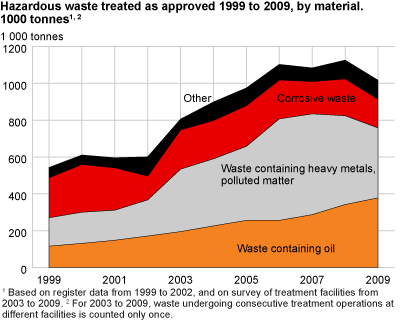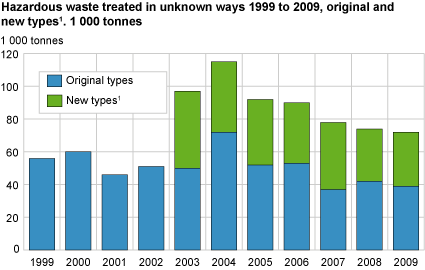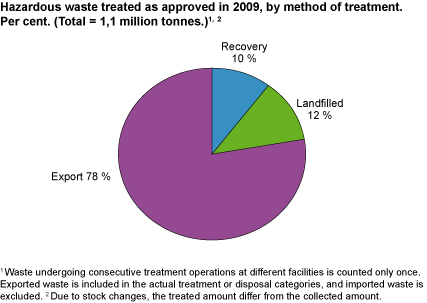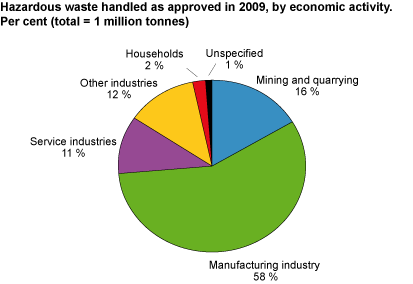Content
Published:
This is an archived release.
Less hazardous waste in 2009
The amount of hazardous waste being collected for approved treatment reached 1.0 million tonnes in 2009, after a 10 per cent decline since 2008. Reduced manufacturing activity is the probable cause. From 1999, however, the amount is near doubled.
Improved collection and reporting are believed to be the main causes of this long-term trend. A certain growth in generated hazardous waste amounts is also believed to have taken place, in line with the economical growth. It is a political target to limit the generation of hazardous waste in order to reduce the risk of emitting pollutants to the environment.
The most abundant waste type in 2009 was waste with heavy metals and polluted mineral matter waste. This waste type comprised 380 000 tonnes in 2009, or 37 per cent of all hazardous waste going to approved treatment. Oil-containing waste also comprised a 37 per cent share, while 15 per cent was corrosive waste, mainly thin acid.
During the last 2 years, the amount of waste with heavy metals and polluted matter declined by 167 000 tonnes, or 31 per cent. One central cause is the cleaning of heavily polluted industrial areas in 2006 and 2007, which gave rise to huge amounts of hazardous polluted matter in these years. Conversely, the amount of oil-containing waste being treated as approved increased by 91 000 tonnes, or 32 per cent, during the last 2 years, due to a steep rise in the collected amount of oil-containing slop.
Falling amounts to unknown handling
Statistics Norway estimates how much hazardous waste goes to unknown handling, which means the waste is not registered as delivered to an approved treatment facility. These estimations are uncertain. According to these estimations, the amounts going to unknown handling declined by 2 000 tonnes in 2009 compared to 2008. Since the peak in 2004 the amounts have dropped by 43 000 tonnes, or 38 per cent. The decline is mainly caused by the increased collection of oil-containing waste, and a drop in the estimated total amount of discarded creosote-impregnated wood.
Due to changes in legislation, several waste types were regarded as hazardous from 2003, including impregnated wood, eternit (asbestos cement) and plastics with brominated flame retardants. The amount of such new types of hazardous waste registered to approved treatment in 2009 was 48 000 tonnes, more than twice as much as in 2003. In the same period the amount going to unknown handling dropped by almost a third, to 33 000 tonnes. The changes in legislation caused a brake in the time series between 2002 and 2003.
The unknown handling of original hazardous waste types not affected by the legislation changes made up 39 000 tonnes in 2009. The long-term trend is a decline here as well, by 31 per cent since 1999. Oil-containing waste like waste oil, sludge from cleaning of tanks and slop water from ships, has made up about four fifths of the original waste types going to unknown handling during the period.
Short-term variation in the amount of hazardous waste going to unknown handling is assumed to be mainly caused by stock changes, while the long-term decline is a result of increased collection.
Exported amounts more than doubled in two years
The Norwegian authorities aim to safeguard national treatment capacity, which means having treatment facilities in Norway or making use of sound alternatives abroad when that proves to be more appropriate. The export of hazardous waste is more than doubled since 2007, and amounted to 154 000 tonnes in 2009. This trend was caused by increased export of oil-containing waste, processing water with a high contamination level, and impregnated wood.
Still, a vast majority of the hazardous waste is treated domestically. About 85 per cent of the hazardous waste entering approved treatment in 2009, or 850 000 tonnes, was treated in Norway. Furthermore, nearly 100 000 tonnes that had been stored from previous years was treated or disposed of.
In total, 22 per cent of the hazardous waste was recovered, i.e. recycled or energy recovered, while the remaining was disposed of, mainly by chemical or physical pre-treatment and subsequent disposal on landfills. Treatment abroad is included in the figures. This distribution was unchanged from 2008.
Also, 268 000 tonnes of hazardous waste was imported to Norway in 2009, representing 20 per cent of all hazardous waste treated at Norwegian facilities. Thirty-eight per cent of the imported amounts was either recycled or energy recovered.
Drop in manufacturing, rise in other industries
The manufacturing industries delivered 583 000 tonnes of hazardous waste to approved treatment in 2009, including internal treatment and disposal. This made up 57 per cent of all hazardous waste treated as approved this year. The amount fell by 47 000 tonnes from 2008. However, the mining and quarrying industries, the construction and demolition industry, and the service industries showed significant increases by between 39 and 48 per cent in the same period.
The most prevalent change is found in the category “unknown source”, which dropped from 184 000 to 9 000 tonnes. The decline is partly a result of improved registration of collected hazardous waste, and partly due to the revision of the industrial classification in 2008. The decline in the category “unknown source” may partly explain the increase in the mining and quarrying industries, the construction and demolition industry, and the service industries.
Steadily more is handed in from households
Households delivered 24 000 tonnes of hazardous waste to approved treatment in 2009, which is up 2 per cent from the previous year. Impregnated wood, paint and waste oil were the major fractions. The amount from households that goes to unknown handling seems to have fallen significantly in recent years, from about 12 000 tonnes in 2003 to 2 000 tonnes in 2009. A somewhat higher uncertainty must be considered in these estimates compared to the figures for approved treatment.
The households deliver significant amounts of electrical and electronic waste, like white goods and mobile phones, to the distributors when buying new goods, or to waste collectors. Such waste is not classified as hazardous waste in Norway, but contains hazardous components and must be delivered separately.
Svalbard
About 100 to 300 tonnes of hazardous waste is collected on Svalbard each year. The amount varies, but is increasing slightly. More than two thirds is oil-containing waste. In 2009, 180 tonnes were handed in, of which 78 per cent was oil-containing waste. The waste is shipped to the mainland for final treatment or disposal.
Hazardous wasteHazardous waste contains substances that may be harmful to human health and the environment. Consequently, there are strict regulations concerning the delivery and treatment of such waste. Moreover, international law puts limits on the export of such waste. Certain waste types with hazardous characteristics are not classified as hazardous waste, as they are covered by other legislation and/or collection schemes. This comprises radioactive waste, infectious waste, discarded medicines, explosives and waste electrical and electronic equipment (WEEE). Hazardous components dismantled from the WEEE are, however, classified as hazardous waste and hence covered by the statistics. Amounts, concentrations and environmental hazardThe statistics do not regard the hazardous substances to differ in concentration and toxicity. Accordingly, waste types contributing insignificantly to the total amounts may be highly relevant from an environmental point of view. This includes waste with PCB, lead accumulators and waste with mercury, which have collected amounts of 2 900 tonnes, 15 000 tonnes and 820 tonnes in 2009 respectively. Revised industrial classificationFrom 2008 and onwards, a new, revised industrial classification (SIC 2007) is applicable. Accordingly, recycling is moved from the manufacturing industry to the sewerage, waste management and water remediation industry. The most predominant effect of the revised classification is a temporary rise in the amount of hazardous waste from unknown industry by about 60 000 tonnes. |
Tables:
- Table 1 Hazardous waste treated as approved 1999 to 2009, by material. 1 000 tonnes.
- Table 2 Hazardous waste to unknown handling 1999 to 2009, by material. 1 000 tonnes.
- Table 3 Hazardous waste treated as approved and handled in unknown ways in 1999 to 2009, total and new types . 1 000 tonnes.
- Table 4 Hazardous waste treated as approved 2003 to 2009, by method of treatment. 1 000 tonnes
- Table 5 Hazardous waste treated as approved 1999 to 2009, by economic activity. 1 000 tonnes.
Additional information
Approved treatment as applied in this article includes only hazardous waste generated in Norway (export is therefore included, while import is excluded).
Contact
-
Gisle Berge
E-mail: gisle.berge@ssb.no
tel.: (+47) 48 12 19 97
-
Terje Lorentzen Landsem
E-mail: terje.landsem@ssb.no
tel.: (+47) 98 84 31 39




